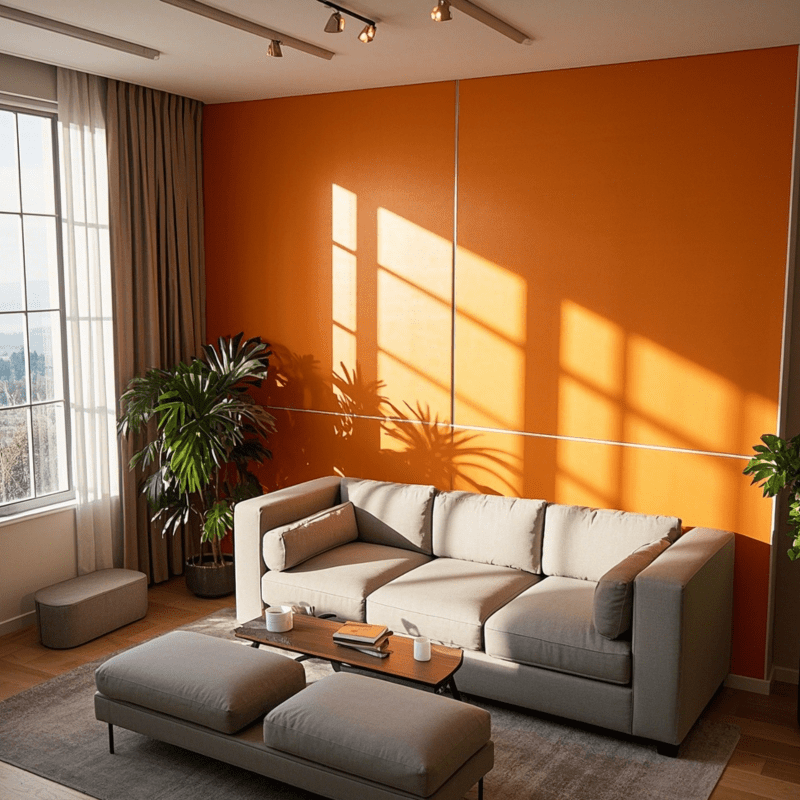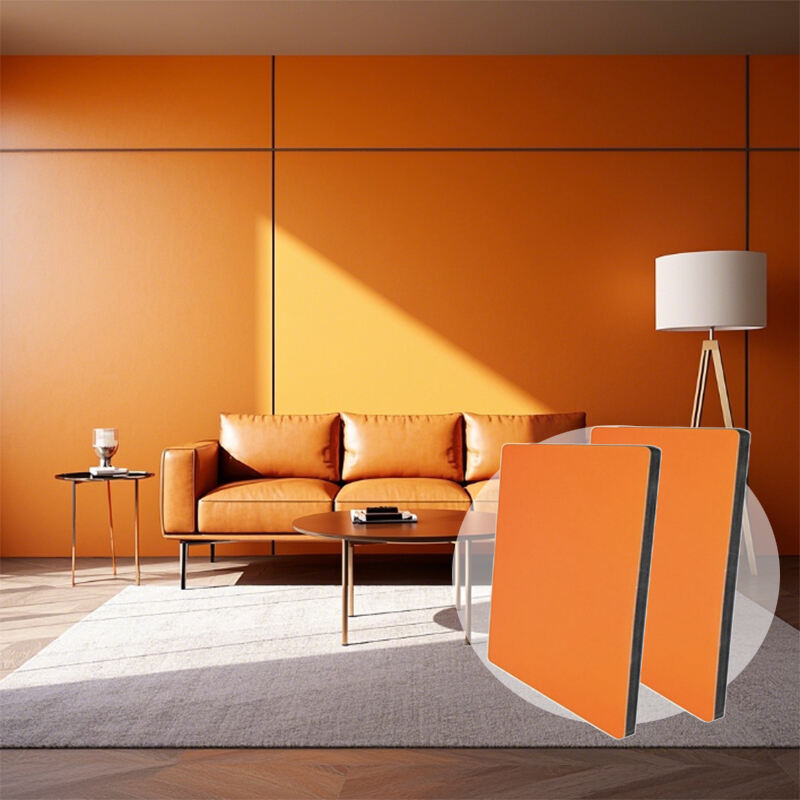ຄວາມມື້ງມື້ງໃນການຕິດຕັ້ງ: ຄະແ້ງຫຼັງສູນ vs ປະເທດຫຼັງສູນ
ການລົບລົ້ມຄວາມຕ້ອງການຂອງລົງທຶນກັບພານທີ່ຕັດລ່ວງໆ
ການໃຊ້ແຜ່ນຝາທີ່ຕັດສໍາເລັດແລ້ວເຮັດໃຫ້ການຕິດຕັ້ງຝາໄວຂຶ້ນຫຼາຍຍ້ອນທຸກຢ່າງມາພ້ອມໃຊ້ງານໄດ້ເລີຍ. ຜູ້ຮັບເໝົາລາຍງານວ່າຕົ້ນທຶນແຮງງານຫຼຸດລົງປະມານ 30% ເມື່ອໃຊ້ແຜ່ນນີ້ແທນວິທີດັ້ງເດີມເຊັ່ນ: ການຖືກົ້ນຍ້ອນມັນງ່າຍຕໍ່ການໃຊ້ງານຫຼາຍຂຶ້ນ. ເວລາທີ່ປະຢັດໄດ້ໝາຍເຖິງພະນັກງານບໍ່ຕ້ອງຢູ່ສະຖານທີ່ດົນເທົ່າທີ່ຄວນ, ເຮັດໃຫ້ທີມງານສາມາດຍ້າຍໄປເຮັດວຽກອື່ນໆໄດ້ພ້ອມກັນຊຶ່ງເພີ່ມປະສິດທິພາບໃນການດໍາເນີນໂຄງການໂດຍລວມ. ເມື່ອແຕ່ລະສະຖານທີ່ຕ້ອງການແຮງງານໜ້ອຍລົງ, ມັນກໍຊັດເຈນແລ້ວວ່າເປັນຫຍັງຜູ້ສ້າງຈຶ່ງມັກໃຊ້ແຜ່ນຕັດສໍາເລັດແບບນີ້ໃນປັດຈຸບັນວ່າຈະເປັນການກໍ່ສ້າງອາຄານອາພາດເມັນຫຼືເຮືອນແຕ່ລະຫຼັງໃນເມືອງ.
ບໍ່ມີການລ້າງທີ່ເທື່ອນັ້ນກັບວິທີການປຸກແຫ່ງ
ກະດານຝາຕິດຕັ້ງໄດ້ໄວກ່ວາການສ້າງຝາດ້ວຍປູນທີ່ຕ້ອງໃຊ້ເວລາແຫ້ງເປັນດົງ. ດ້ວຍວິທີນີ້ ໂຄງການຈະສຳເລັດໄວຂຶ້ນ. ອາຄານທີ່ໃຊ້ໃນການຄ້າສາມາດເປີດປະຕູໃຫ້ບໍລິການໄດ້ເທື່ອ, ຊຶ່ງໝາຍຄວາມວ່າເຈົ້າຂອງທຸລະກິດສາມາດເລີ່ມຫາເງິນໄດ້ໄວຂຶ້ນ. ສຳລັບຜູ້ພັດທະນາ, ຄວາມໄວນີ້ກໍ່ເຮັດໃຫ້ຜົນຕອບແທນການລົງທຶນດີຂຶ້ນ ເນື່ອງຈາກຊັບສິນສາມາດຜະລິດລາຍຮັບໄດ້ກ່ອນກຳນົດ. ບໍລິສັດກໍ່ສ້າງກໍໄດ້ປະໂຫຍດດ້ວຍເຊັ່ນກັນ ເນື່ອງຈາກສາມາດສຳເລັດໂຄງການໄດ້ໄວຂຶ້ນ, ໄດ້ຮັບເງິນຈ່າຍໄວຂຶ້ນ ແລະ ສາມາດປ່ອຍຊັບພະຍາກອນອອກໄປໃຊ້ໃນວຽກອື່ນໆໄດ້. ເມື່ອທຽບກັບວິທີດັ້ງເດີມໃນການທາປູນ, ການໃຊ້ກະດານຝາໃນທາງດ້ານການເງິນແລ້ວມັນມີເຫດຜົນທີ່ດີກ່ວາສຳລັບທຸກຄົນທີ່ກ່ຽວຂ້ອງໃນຂະບວນການກໍ່ສ້າງ.
ຄວາມສຸດສະດຸການສາງຂອງລະບົບແຜນປະຕູສະຫະລັດ
Gypsum Board ຜູ້ໆນ້ອຍຫຼາຍລົງສຳຫຼັບການຫຼຸດຄວາມຖ້້ອຂອງອາຄານ
ແຜ່ນຢິບຊັມມີນ້ຳໜັກເບົາກ່ວາວັດສະດຸສ້າງຕັ້ງອື່ນໆ, ສິ່ງນີ້ເຮັດໃຫ້ມີຄວາມແຕກຕ່າງໃນການປະຕິບັດງານຂອງສະຖາປັດຕິກ. ເນື່ອງຈາກມັນບໍ່ໜັກຫຼາຍ, ນັກສະຖາປັດຕິກມີຄວາມເສລີພາບຫຼາຍຂຶ້ນໃນການອອກແບບອາຄານຍ້ອນວ່າມີການກົດດັນໜ້ອຍລົງຕໍ່ລະບົບພື້ນຖານ. ເມື່ອພື້ນຖານບໍ່ຈຳເປັນຕ້ອງຮັບນ້ຳໜັກຫຼວງຫຼາຍ, ຜູ້ຮັບເໝົາສາມາດນຳໃຊ້ວິທີກໍ່ສ້າງທີ່ງ່າຍຂຶ້ນໄດ້ເປັນບາງຄັ້ງ, ແລະໂດຍທົ່ວໄປແລ້ວສິ່ງນີ້ຫມາຍເຖິງຄ່າໃຊ້ຈ່າຍໃນການກໍ່ສ້າງທີ່ຕໍ່າລົງ. ນ້ຳໜັກທີ່ຫຼຸດລົງຍັງຊ່ວຍຫຼຸດການນຳໃຊ້ວັດສະດຸໃນທົ່ວທັງລະບົບກອບ, ສິ່ງທີ່ມີຄວາມສຳຄັນຫຼາຍໃນການເຄື່ອນໄຫວດ້ານສິ່ງແວດລ້ອມໃນປັດຈຸບັນທີ່ທຸກຄົນຕ້ອງການຫຼຸດຜ່ອນຂີ້ເຫຍື້ອ. ພວກເຮົາເຫັນຂໍ້ດີນີ້ກຳລັງສະແດງຜົນຢູ່ທົ່ວທຸກແຫ່ງໃນປັດຈຸບັນ - ຈາກເຮືອນຂະໜາດນ້ອຍຂອງຄອບຄົວຈົນເຖິງສະໂມສອນຫ້ອງການຂະໜາດໃຫຍ່, ແຜ່ນຢິບຊັມສືບຕໍ່ສະແດງໃຫ້ເຫັນເຫດຜົນທີ່ພວກມັນຍັງຄົງນິຍົມໃຊ້ຢູ່ເຖິງວ່າຈະມີທາງເລືອກໃໝ່ໆເຂົ້າສູ່ຕະຫຼາດ.
ການປ່ຽນແປງທີ່ແບບໆແລ້ວໂດຍບໍ່ມີການສັນຍາສານ
ກະດານຝາປັດຈຸບັນໄດ້ກາຍເປັນສິ່ງທີ່ມີຄວາມສຳຄັນໃນການກໍ່ສ້າງຍຸກໃໝ່ ເນື່ອງຈາກມັນບໍ່ຕ້ອງຮັບນ້ຳໜັກ ເຊິ່ງເຮັດໃຫ້ການປັບປຸງຝາງ່າຍຂຶ້ນຫຼາຍ ສຳເລັດໄວກ່ວາວິທີການດັ້ງເດີມ. ພໍ່ບ້ານສາມາດປັບປຸງພື້ນທີ່ຕາມໃຈຕ້ອງການໂດຍບໍ່ຕ້ອງກັງວົນກ່ຽວກັບການປ່ຽນແປງທາງໂຄງສ້າງທີ່ໃຫຍ່ໂຕ ຫຼື ອັນຕະລາຍທີ່ອາດເກີດຂຶ້ນ. ຍົກຕົວຢ່າງເຊັ່ນ ການຕິດຕັ້ງຝາ ສິ່ງທີ່ເກົ່າກ່ອນໜ້ານີ້ຕ້ອງໃຊ້ເວລາຫຼາຍອາທິດໃນການກໍ່ສ້າງຝາດ້ວຍປູນ ແຕ່ປັດຈຸບັນສາມາດເຮັດໄດ້ພາຍໃນບໍ່ກີ່ມື້ດ້ວຍກະດານຝາ. ຊ່າງກໍ່ສ້າງມັກຄວາມຍືດຫຍຸ່ນນີ້ ເນື່ອງຈາກມັນຊ່ວຍປະຢັດເວລາ ແລະ ຄ່າໃຊ້ຈ່າຍໃນໂຄງການ. ນັກທຸລະກິດດ້ານອະສັງຫາລິມະຊັບກໍເຫັນປະໂຫຍດນີ້ເຊັ່ນດຽວກັນ ໂດຍສະເພາະໃນການຈັດການກັບອາຄານເກົ່າທີ່ຕ້ອງການປັບປຸງແຕ່ບໍ່ສາມາດຮັບການປັບປຸງໃຫຍ່ໄດ້. ນັກພັດທະນາອະສັງຫາລິມະຊັບທົ່ວປະເທດກຳລັງນິຍົມກຳນົດໃຊ້ລະບົບກະດານຝາໃນການກໍ່ສ້າງໃໝ່ ເນື່ອງຈາກມັນສະເໜີຄວາມສະດວກໃນການປັບປຸງພື້ນທີ່ໃນອະນາຄົດ ແລະ ສາມາດຮັກສາຄວາມໝັ້ນຄົງ ແລະ ຄວາມປອດໄພໄດ້ດີ.
ຄວາມສຳເລັດຂອງພື້ນໜ້າແລະຄວາມສະເຫຼ່ຍຂອງການສຳເລັດ
ຄວາມເປັນຫນ້ອຍທີ່ຖືກດຳເນີນໂດຍພະລັງງານຂອງສະໜາຄາ
ຜູ້ຜະລິດຜະລິດແຜ່ນຝາພາຍໃນໂຮງງານທີ່ຄວບຄຸມຢ່າງເຂັ້ມງວດ ສະນັ້ນຄວາມໜາ ແລະ ລວງດວງຂອງແຜ່ນຈຶ່ງຄ້າຍຄືກັນທຸກຄັ້ງ. ເມື່ອທຸກຢ່າງຄົບຖ້ວນໃນຂະນະຜະລິດ ກໍ່ຈະເຮັດໃຫ້ບັນຫາຫຼັງຈາກນັ້ນຫຼຸດລົງເມື່ອຄົນພະຍາຍາມປິດຝາ. ນັກກໍ່ສ້າງມັກເລີຍເພາະວ່າວຽກຂອງເຂົາເຈົ້າດຳເນີນໄປຢ່າງລຽບລຽນ ໂດຍບໍ່ມີບັນຫາສ່ວນທີ່ຜິວໜ້າມີຄວາມຮູ້ສຶກແຕກຕ່າງກັນ. ຄຸນນະພາບທີ່ສະເໝີກັນຍັງໝາຍເຖິງຜົນໄດ້ຮັບທີ່ດີຂຶ້ນໃນການທາສີ ເນື່ອງຈາກວ່າສີແຜ່ອອກໄປຢ່າງສະເໝີພາບໃນທົ່ວພື້ນຜິວ ແທນທີ່ຈະລວມຕົວກັນໃນບາງເຂດ ແລະ ມີສີຈື່ງແຈ້ງໃນບ່ອນອື່ນ. ສຳລັບນັກຜັນແປງ ແລະ ນັກອອກແບບທີ່ກຳລັງເຮັດໂຄງການທີ່ທັນສະໄໝໃນມື້ນີ້ ການຊອກຫາຄວາມສົມດຸນລະຫວ່າງການເບິ່ງດີ ແລະ ການເຮັດວຽກໄດ້ດີແມ່ນມີຄວາມສຳຄັນຫຼາຍ. ສະນັ້ນຈຶ່ງເຮັດໃຫ້ມີການກຳນົດເອົາແຜ່ນທີ່ຜະລິດຢ່າງສອດຄ່ອງແບບນີ້ເຂົ້າໄປໃນຫຼາຍໆການອອກແບບ.

ຄຸນລັກສະນະກັບຫນ້າວ່າສັນຍາກັບການຫຼຸດລົງ
ພາບໜ້າກຳແພງມີບາງສິ່ງບາງຢ່າງທີ່ດີກ່ວ່າປູນທຳມະດາໃນການແກ້ໄຂບັນຫາການແຕກເສຍຍ. ພວກມັນສາມາດຕ້ານທານກັບການແຕກເສຍຍອັນເນື່ອງມາຈາກການຫົດໂຕທີ່ມັກຈະເກີດຂຶ້ນກັບກຳແພງທີ່ເຮັດດ້ວຍປູນຫຼັງຈາກໃຊ້ໄປໄດ້ສັກພັກໜຶ່ງ. ພື້ນຜິວຍັງຄົງມີຄວາມກົມກຽມດີກ່ວາເກົ່າ ເຊິ່ງໝາຍເຖິງການໃຊ້ເວລາໜ້ອຍລົງໃນການບຳລຸງຮັກສາຕໍ່ມາ. ກຳແພງຍັງມີອາຍຸການໃຊ້ງານຍາວນານຂຶ້ນເນື່ອງຈາກມີຄວາມສຶກເສຍຍໜ້ອຍລົງ. ບາງການສຶກສາຊີ້ໃຫ້ເຫັນວ່າຄົນທີ່ຍ້າຍຈາກການໃຊ້ປູນແບບດັ້ງເດີມມາເປັນພາບໜ້າກຳແພງທີ່ທັນສະໄໝຈະໃຊ້ເງິນໜ້ອຍລົງປະມານ 25 ເປີເຊັນໃນການບຳລຸງຮັກສາຕໍ່ມາ. ສິ່ງນີ້ເບິ່ງຄືມີເຫດຜົນເນື່ອງຈາກບໍ່ມີໃຜຢາກເສຍເວລາກັບວຽກງານອຸດໜູນຕະຫຼອດເວລາວ່າຈະເປັນເຈົ້າຂອງອາພາດເມັນຂະໜາດນ້ອຍ ຫຼື ກຳລັງຄອບຄອງພື້ນທີ່ຫ້ອງການຂະໜາດໃຫຍ່ກໍຕາມ.
ການเปรียบเทียบຄุณสมบัติทางเสียงและอุณหภูมิ
ເทັກນໂລໂຈີ ຄົນເສີງ-dampening
ໃນມື້ນີ້ ແຜ່ນຝາ ມາພ້ອມກັບເຕັກໂນໂລຊີຕັດສຽງລົບກວນທີ່ດີເລີດ ທີ່ຊ່ວຍຫຼຸດສຽງທີ່ເຄື່ອນທີ່ຈາກຫ້ອງໜຶ່ງໄປຫ້ອງອື່ນ. ພວກມັນເໝາະສຳລັບໃຊ້ໃນສະຖານທີ່ເຊັ່ນ ອາຄານສຳນັກງານ ແລະ ໂຮງແຮມອາພາດເມັນ ບ່ອນທີ່ຄົນຕ້ອງການຄວາມເປັນສ່ວນຕົວ ແລະ ຕ້ອງການຫຼີກເວັ້ນສຽງລົບກວນ. ການທົດສອບບາງຢ່າງທີ່ນັກຄົ້ນຄວ້າໄດ້ດຳເນີນກໍໄດ້ສະໜັບສະໜູນເລື່ອງນີ້, ພົບວ່າແຜ່ນຝາທີ່ທັນສະໄໝສາມາດກັ້ນສຽງໄດ້ຫຼາຍກ່ວາຝາປູນທຳມະດາເຖິງເຄິ່ງໜຶ່ງ. ຄວາມແຕກຕ່າງນີ້ມີຜົນກະທົບຢ່າງໃຫຍ່ຫຼວງໃນສະພາບແວດລ້ອມທີ່ຄວາມສະຫງົບສຳຄັນຫຼາຍ, ສຳນັກງານໃຫຍ່ທີ່ຕ້ອງການຫ້ອງປະຊຸມທີ່ເງິບ, ອາພາດເມັນທີ່ຜູ້ຢູ່ບ້ານບໍ່ຢາກໄດ້ຍິນການສົນທະນາທັງໝົດ, ຫຼື ນັກທ່ອງທ່ຽວທີ່ຄາດຫວັງຄວາມສະຫງົບເວລາພັກຜ່ອນຢູ່ໂຮງແຮມ.
ແປນທີ່ຕ້ອງການຕ້ອງກັບການຕັ້ງຄ່າໃນຫ້ອງນ້ຳ
ແຜ່ນຝາກັນຊື້ນກາຍເປັນສິ່ງທີ່ຈໍາເປັນຢ່າງແທ້ຈິງເມື່ອຕ້ອງຈັດການກັບບັນດາບ່ອນທີ່ມີຄວາມຊື້ນສູງທີ່ພວກເຮົາຮູ້ຈັກດີ - ຫ້ອງນ້ໍາຂອງພວກເຮົາ. ການອອກແບບພິເສດຂອງແຜ່ນຝາເຫຼົ່ານີ້ແກ້ໄຂບັນຫາທີ່ເກີດຈາກຄວາມຊື້ນເກີນຈໍາເປັນໄດ້ຢ່າງມີປະສິດທິພາບ ແລະ ສົກກີດການເຕີບໂຕຂອງເຊື້ອເຫັດ ແລະ ປ້ອງກັນຄວາມເສຍຫາຍຕໍ່ໂຄງສ້າງເອງ. ສໍາລັບຜູ້ທີ່ເປັນເຈົ້າຂອງເຮືອນ, ການມີຜະລິດຕະພັນປະເພດນີ້ຊ່ວຍໃຫ້ພວກເຂົາຮູ້ສຶກໝັ້ນໃຈວ່າຝາຫ້ອງນ້ໍາຂອງພວກເຂົາຈະບໍ່ພັງທະລາຍໄປຕາມການເວລາ ແລະ ຍັງຮັກສາລັກສະນະໃຫ້ເບິ່ງດີເໝືອນໃໝ່ໄດ້ຢູ່ຕະຫຼອດ. ການສຶກສາທີ່ຜ່ານມາຍັງສະໜັບສະໜູນສິ່ງທີ່ເຈົ້າຂອງເຮືອນຫຼາຍຄົນເຄີຍຄິດໄວ້: ວັດສະດຸທີ່ກັນຄວາມຊື້ນມີອາຍຸການໃຊ້ງານຍາວນານກ່ວາວັດສະດຸທົ່ວໄປປະມານ 40% ໃນບັນດາບ່ອນທີ່ມີນ້ໍາ ແລະ ແອ້ມ. ຄວາມທົນທານເພີ່ມເຕີມນີ້ເຮັດໃຫ້ແຕກຕ່າງຢ່າງແທ້ຈິງໃນການຮັກສາຝາຫ້ອງນ້ໍາໃຫ້ແຂງແຮງຕະຫຼອດປີ ແມ້ຈະຖືກສໍາຜັດກັບນ້ໍາ ແລະ ແອ້ມຢ່າງຕໍ່ເນື່ອງ.
ການຈັດການຄວາມຊຸມ ແລະ ການປ້ອງກັນເຫຼືອງ
ການປະຕິບັດຂອງ Green Board ໃນເຂດທີ່ມີຄວາມຊຸມ
ແຜ່ນບອດສີຂຽວໄດ້ກາຍເປັນໜຶ່ງໃນທາງເລືອກອັນດັບຕົ້ນໆເມື່ອປະກົດການຕິດຕັ້ງພະນັງໃນບັນດາພື້ນທີ່ທີ່ມັກຈະຊຸ່ມຊື່ນເຊັ່ນ: ໂຄີນຫຼືຫ້ອງນ້ຳ. ສິ່ງທີ່ເຮັດໃຫ້ຜະລິດຕະພັນນີ້ມີຄວາມພິເສດແມ່ນການຕ້ານທານຕໍ່ການຊຶມຜ່ານຂອງຄວາມຊື່ນ. ການທົດສອບສະແດງໃຫ້ເຫັນວ່າມີເຊື້ອເຫັດເຕີບໂຕໜ້ອຍລົງປະມານ 30 ເປີເຊັນໃນພື້ນຜິວທີ່ເຮັດມາຈາກແຜ່ນບອດສີຂຽວເມື່ອທຽບກັບວັດສະດຸແຜ່ນຍິບຊີເມັງປົກກະຕິໃນໄລຍະຍາວ. ພວກນັກກໍ່ສ້າງທີ່ສົນໃຈກ່ຽວກັບຄວາມຍືນຍົງພົບເຫັນເຖິງຄຸນຄ່າໃນແຜ່ນບອດເຫຼົ່ານີ້ຍ້ອນມັນເຂົ້າກັນກັບມາດຕະຖານທີ່ກຳນົດໄວ້ໂດຍໂຄງການຮັບຮອງຄວາມເປັນມິດກັບສິ່ງແວດລ້ອມ (LEED) ແລະ ອື່ນໆ. ສຳລັບຜູ້ທີ່ກຳລັງກໍ່ສ້າງພື້ນທີ່ທີ່ມີລະດັບຄວາມຊື່ນສູງຂຶ້ນເປັນປະຈຳ, ແຜ່ນບອດສີຂຽວສະເໜີການປົກປ້ອງທີ່ເໝາະສົມຕໍ່ກັບຄວາມເສຍຫາຍຈາກນ້ຳໃນຂະນະທີ່ຍັງສາມາດຕອບສະໜອງຕາມຂໍ້ກຳນົດດ້ານສິ່ງແວດລ້ອມຂອງການກໍ່ສ້າງໄດ້.
ຄວາມສາມາດການປະສານກັບກະແຈກັບຄວາມເປັນ
ເມື່ອຊັ້ນກັ້ນຄວາມຊື້ນຖືກປະສົມເຂົ້າກັບລະບົບຜະນັງ, ມັນຈະເພີ່ມປະສິດທິພາບໃນການຄວບຄຸມຄວາມຊື້ນ ແລະ ຊ່ວຍໃຫ້ອາຄານມີອາຍຸການໃຊ້ງານຍາວນານຂຶ້ນ. ຊັ້ນກັ້ນຄວາມຊື້ນທີ່ດີຈະຊ່ວຍບໍ່ໃຫ້ຄວາມຊື້ນເຂົ້າໄປພາຍໃນຜະນັງ, ຊຶ່ງຈະຊ່ວຍຮັກສາສະພາບແວດລ້ອມພາຍໃນໃຫ້ມີສຸຂະພາບດີຂຶ້ນ. ຄວາມຊື້ນທີ່ໜ້ອຍລົງຍັງໝາຍເຖິງຄວາມເປັນໄປໄດ້ທີ່ຈະເກີດຄວາມເສຍຫາຍຕໍ່ໂຄງສ້າງ ແລະ ການເຕີບໂຕຂອງເຊື້ອເຫັດອັນຕະລາຍທີ່ບ່ອນທີ່ບໍ່ມີໃຜຢາກໃຫ້ມັນເກີດຂຶ້ນ. ຜົນປະໂຫຍດບໍ່ໄດ້ຢຸດຢູ່ທີ່ການຮັກສາຄວາມແຫ້ງເທົ່ານັ້ນ. ບ້ານທີ່ມີການຄຸ້ມຄອງຄວາມຊື້ນຢ່າງເໝາະສົມມັກຈະຂາຍໄດ້ລາຄາດີກວ່າໃນຕະຫຼາດ. ປະຊາຊົນທີ່ຊື້ເຮືອນໃນປັດຈຸບັນນີ້ເລີ່ມສົນໃຈຊອກຫາຄຸນສົມບັດແບບນີ້ເນື່ອງຈາກຮູ້ດີວ່າຄວາມເສຍຫາຍຈາກນ້ຳສາມາດເຮັດໃຫ້ເກີດບັນຫາຫຼາຍຢ່າງ. ບ້ານທີ່ຖືກສ້າງຂຶ້ນດ້ວຍການຄວບຄຸມຄວາມຊື້ນຢ່າງສະຫຼາດບໍ່ພຽງແຕ່ເປັນປະໂຫຍດໃນການໃຊ້ງານເທົ່ານັ້ນ, ແຕ່ຍັງຊ່ວຍໃຫ້ບ້ານດຶງດູດຜູ້ຊື້ທີ່ສົນໃຈເລື່ອງອາກາດທີ່ສະອາດ ແລະ ຄ່າໃຊ້ຈ່າຍໃນການບຳລຸງຮັກສາໃນໄລຍະຍາວນານຂຶ້ນ.
ການວິເຄາະຄ່າ-ຜົນລົງທຶນໃນເວລາ
ຄ່າຕິດຕັ້ງຕໍ່ເນື່ອງທີ່ຕ່ຳກວ່າ
ການຕິດຕັ້ງກະດານຜົນຝາແທ້ຈິງຊ່ວຍປະຢັດເງິນໄດ້, ມັກຈະໃຊ້ຈ່າຍໜ້ອຍລົງປະມານ 20 ຫາ 30 ສ່ວນຮ້ອຍຕໍ່ຕາແມັດກ້າມທຽບກັບວິທີດັ້ງເດີມໃນການຖິ້ມປູນ. ການປະຢັດເງິນເຫຼົ່ານີ້ຈະເພີ່ມຂຶ້ນໃນທົ່ວທັງໂຄງການ, ເຮັດໃຫ້ຜູ້ຮັບເໝົາມີພື້ນທີ່ຫາຍໃຈໃນການຄຸ້ມຄອງງົບປະມານ. ພວກເຂົາມັກເລີຍຍ້ອນວ່າພວກເຂົາໃຊ້ເວລາໜ້ອຍລົງໃນການເຮັດວຽກແລະຄ່າໃຊ້ຈ່າຍທີ່ກ່ຽວຂ້ອງ, ຊຶ່ງໝາຍເຖິງກຳໄລທີ່ດີຂຶ້ນ. ພວກເຂົາສາມາດຖ່າຍໂອນການປະຢັດເງິນເຫຼົ່ານີ້ໃຫ້ແກ່ລູກຄ້າໃນຂະນະທີ່ຍັງສົ່ງເສີມໃຫ້ມີຄຸນນະພາບດີ. ການລົງທຶນໜ້ອຍລົງໃນເບື້ອງຕົ້ນບໍ່ໄດ້ໝາຍເຖິງການຍົກເລີກບາງຢ່າງໃນດ້ານຮູບລັກສະນະ ຫຼື ຄວາມທົນທານ. ກະດານຜົນຝາສາມາດຢູ່ໄດ້ດົນໃນໄລຍະຍາວ ແລະ ສະໜອງຜົນຝາທີ່ເນີຍແລະທັນສະໄໝທີ່ທຸກຄົນຕ້ອງການ. ນັ້ນແມ່ນເຫດຜົນທີ່ຜູ້ຮັບເໝົາຈຳນວນຫຼວງຫຼາຍແນະນຳໃຊ້ສຳລັບທຸກຢ່າງຕັ້ງແຕ່ການປັບປຸງນ້ອຍໆໄປຈົນເຖິງໂຄງການກໍ່ສ້າງຂະໜາດໃຫຍ່.
ลดค่าใช้จ่ายการบำรุงรักษาในระยะยาว
ການຫັນເອົາຜົນຝາປູນແບບດັ້ງເດີມໄປສູ່ກະດານຝາທີ່ທັນສະໄໝນັ້ນເຮັດໃຫ້ປະຢັດເງິນໃນການບຳລຸງຮັກສາໃນໄລຍະຍາວ ເນື່ອງຈາກກະດານເຫຼົ່ານີ້ບໍ່ສຶກເສຍຫຼາຍ ແລະ ຕ້ອງການການຊຳລະໜ້ອຍລົງຫຼາຍ. ບັນດາຜູ້ຊຳນິຊຳນານດ້ານອະສັງຫາລິມະຊັບລາຍງານວ່າ ທີ່ພັກອາໄສມັກຈະໃຊ້ເງິນໃນການບຳລຸງຮັກສາຝາໜ້ອຍລົງປະມານ 25 ເປີເຊັນໃນໄລຍະເວລາຫຼາຍໆປີ ຖ້ຽມກັບລະບົບປູນເກົ່າ. ເຫດຜົນເປັນຫຍັງ? ກະດານຝາສາມາດຕ້ານທານຕໍ່ຄວາມເສຍຫາຍ ແລະ ການເຖົ້າລົງຂອງເວລາໄດ້ດີຂຶ້ນ ເຊິ່ງໝາຍເຖິງການເດີນທາງໄປຮ້ານສີໜ້ອຍລົງ ແລະ ບໍ່ຈຳເປັນຕ້ອງໂທຫາຜູ້ຮັບເໝົາບໍ່ເທື່ອ. ສຳລັບຜູ້ທີ່ເບິ່ງການລົງທຶນໃນຊັບສິນຂອງຕົນເອງ ສິ່ງນີ້ກໍເຮັດໃຫ້ຜົນຕອບແທນດີຂຶ້ນ ເນື່ອງຈາກບໍ່ຈຳເປັນຕ້ອງເສຍເວລາໃນການບຳລຸງຮັກສາຫຼາຍ. ນອກຈາກນັ້ນ ເມື່ອຝາສາມາດຢູ່ໄດ້ດົນໂດຍບໍ່ພັງເສຍ ມັນກໍເຂົ້າໃຈໄດ້ວ່າເປັນຫຍັງຜູ້ສ້າງຕຶກຈຶ່ງເລືອກໃຊ້ກະດານຝາໃນທຸກມື້ນີ້ເປັນທາງເລືອກທີ່ສະຫຼາດກ່ວາວັດສະດຸແບບດັ້ງເດີມ.
ປັດຈັບທີ່ເປັນມະຫາສຳຄັນໃນການສ້າງສຳລັບປະຈຸບັນ
ລາວຸ່ມທີ່ສາມາດຮັບຊົງໄດ vs ປະເພົາແຫຼຸ່ງ
ໃນມື້ນີ້, ແຜ່ນຝາກັ້ນກໍາລັງໄດ້ຮັບຄວາມສົນໃຈຍ້ອນເປັນມິດກັບສິ່ງແວດລ້ອມເນື່ອງຈາກມັນປະກອບດ້ວຍປູນແກ້ວທີ່ສາມາດນໍາມາໃຊ້ໃໝ່ໄດ້. ຄວາມເປັນຈິງທີ່ວ່າມັນສາມາດເຂົ້າກັນໄດ້ກັບໂຄງການສ້າງຕຶກອາຄານສີຂຽວໝາຍເຖິງຂยะເຊິ່ງຈະໄປສິ້ນສຸດໃນສະຖານທີ່ຖິ້ມຂยะຈະໜ້ອຍລົງເມື່ອປຽບທຽບກັບວິທີການເກົ່າກ່ວາ. ປູນທົ່ວໄປສ່ວນຫຼາຍມາຈາກການຂຸດເຈາະແລະບໍ່ໄດ້ມີຂໍ້ໄດ້ປຽບດ້ານການນໍາໃຊ້ໃໝ່ເຊັ່ນດຽວກັນ. ສໍາລັບຜູ້ຮັບເໝົາທີ່ຕ້ອງການສ້າງສິ່ງກໍ່ສ້າງຢ່າງຍືນຍົງ, ແຜ່ນຝາກັ້ນພຽງແຕ່ເຮັດໃຫ້ມີຄວາມຮູ້ສຶກດີຂຶ້ນໃນແງ່ສິ່ງແວດລ້ອມ. ການສຶກສາໄດ້ສະແດງໃຫ້ເຫັນວ່າອາຄານທີ່ສ້າງດ້ວຍວັດຖຸດິບທີ່ສາມາດນໍາມາໃຊ້ໃໝ່ໄດ້ມັກຈະຫຼຸດການປ່ອຍອາຍພິດຄາບອນລົງໄດ້ປະມານ 30%. ເມື່ອຜູ້ສ້າງອາຄານເລືອກໃຊ້ແຜ່ນຝາກັ້ນແທນທີ່ຈະໃຊ້ປູນທົ່ວໄປ, ພວກເຂົາກໍເຊັກບັອກເພື່ອຄວາມຖືກຕ້ອງຕາມລະບຽບກົດໝາຍໃນຂະນະທີ່ສະແດງໃຫ້ເຫັນເຖິງຄວາມອຸທິດຕົນຕໍ່ການປົກປ້ອງດາວດິນ. ວິທີການນີ້ມັກຈະເອົາໃຈເສີມໃຫ້ແກ່ລູກຄ້າທີ່ສົນໃຈກ່ຽວກັບຜົນກະທົບຕໍ່ສິ່ງແວດລ້ອມຂອງເຂົາເຈົ້າເຊັ່ນກັນ.
ການປຸກ້າຍຄວາມມີຄວາມສຳເລັດໃນການຜະລິດ
ຜູ້ຜະລິດໄດ້ເຮັດໃຫ້ມີການກ້າວພົ້ນໃນຂະບວນການຜະລິດແຜ່ນຝາຜະນັງໃນເວລາບໍ່ດົນມານີ້, ສິ່ງທີ່ຫມາຍຄວາມວ່າພວກເຮົາກໍາລັງເຫັນປະສິດທິພາບດ້ານພະລັງງານທີ່ດີຂື້ນແລະຂີ້ເຫຍື້ອຫຼຸດລົງໂດຍລວມ. ການປ່ຽນແປງເຫຼົ່ານີ້ເຮັດໃຫ້ຕົ້ນທຶນການຜະລິດຂອງບໍລິສັດຫຼຸດລົງ, ສິ່ງທີ່ເຂົ້າໃຈໄດ້ເມື່ອເບິ່ງມາດຕະຖານສ້າງສາງຄ໌ສີຂຽວເຊັ່ນກັນ. ຕາມການສຶກສາໃໝ່ໆ, ການຜະລິດແບບສີຂຽວຫຼຸດການໃຊ້ພະລັງງານລົງປະມານ 40 ເປີເຊັນເມື່ອທຽບກັບວິທີການດັ້ງເດີມ. ສິ່ງນີ້ຫມາຍເຖິງຫຍັງ? ກ່ອນອື່ນໝົດ, ມັນເຮັດໃຫ້ການຜະລິດຍືນຍົງຫຼາຍຂື້ນໃນຂະນະທີ່ປັບປຸງປະສິດທິພາບດ້ານພະລັງງານຂອງອາຄານທີ່ແຜ່ນຝາຜະນັງຖືກຕິດຕັ້ງ. ເມື່ອຜູ້ຮັບເໝົາເລືອກໃຊ້ແຜ່ນຝາຜະນັງທີ່ຜະລິດຜ່ານຂະບວນການໃໝ່ເຫຼົ່ານີ້, ພວກເຂົາຊ່ວຍຫຼຸດຜ່ອນຜົນກະທົບຕໍ່ສິ່ງແວດລ້ອມຂອງໂຄງການຂອງພວກເຂົາ. ການປ່ຽນແປງນີ້ສະໜັບສະໜູນສິ່ງທີ່ຫຼາຍຄົນກໍາລັງຮຽກຮ້ອງໃນອຸດສະຫະກໍາກໍ່ສ້າງໃນປັດຈຸບັນນີ້ - ການຍ້າຍໄປສູ່ການປະຕິບັດທີ່ເປັນມິດກັບດາວດິນຂອງພວກເຮົາໂດຍບໍ່ຕ້ອງສູນເສຍຄຸນນະພາບຫຼືການໃຊ້ງານ.
ພາກ FAQ
ຫຼັງຈາກນັ້ນ, ມີຄວາມເປັນຫຼາຍຂອງການໃຊ້ wall boards ແມ່ນຫຍັງຫຼາຍກວ່າການໃຊ້ແຜ່ນປະເທດ?
ບ້ານ ບອດສະຫຼາຍຄ້າຍການເຮັດວຽກ, ເຂົ້າໃນການຕິດຕັ້ງໄວໆ, ແລະມີຜົນປະໂຫຍດທີ່ດີກວ່າຈາກນ້ຳໜັກທີ່ແKeith. ມັນຍັງຊ່ວຍໃນການຈັດການນ້ຳແລະການຍຸດເສີງ, ໂດຍເຮັດໃຫ້ມັນເປັນທີ່ສົ່ງສຳລັບສະພາບແວ່ງທີ່ຫຼາຍ.
ເປັນຫຍັງແຜ່ນຝາຜະນັງຈຶ່ງຖືກຈັດເປັນວ່າຄຸ້ມຄ່າກວ່າ?
ບ້ານ ບອດມີຄ່າຕິດຕັ້ງຕໍ່ເນື່ອງທີ່ຕ່ຳກວ່າແລະຕ້ອງການການຮັກສານ້ອຍກວ່າໃນເວລາ, ໂດຍເຮັດໃຫ້ມີການເບິ່ງເຫັນທີ່ສູງໃນຄ່າໃຊ້ຈ່າຍທີ່ສັ້ນແລະຍາວ.
ບ້ານ ບອດສະຫຼາຍໃຫ້ມີສ່ວນຮ່ວມໃນການປົກປ້ອນແຫ່ງສິ່ງແວດລ້ອມແນວໃດ?
ບ້ານ ບອດມີການນຳໃຊ້ເຂົາສິ່ງທີ່ສາມາດຮັບຊື້ໄດ້ແລະຖືກຜົນิตໂດຍການເຮັດວຽກທີ່ມີຄວາມມັນທີ່ສູງ, ໂດຍເຮັດໃຫ້ມັນສົງສິນກັບການສ້າງສິ່ງທີ່ເປັນມິດຕະພາບແລະຫຼຸດຄວາມເປັນການຂອງການສ້າງທັງໝົດ.
ບ້ານ ບອດສາມາດນຳໃຊ້ໃນສະພາບແວ່ງທີ່ມີຄວາມຊຸມສູງໄດ້ບໍ່?
ແມ່ນ, ບ້ານ ບອດທີ່ມີຄວາມຕ້ອງການຕໍ່ນ້ຳພິເສດມີຢູ່, ໂດຍເຮັດໃຫ້ມັນສົງສິນສຳລັບຫ້ອງນ້ຳແລະຫ້ອງອາຫານໂດຍກາຍກັນເຊື້ອຫຼາຍແລະຫຼຸດຄວາມເປັນການຂອງສາມາດ.
ສາລະບານ
- ຄວາມມື້ງມື້ງໃນການຕິດຕັ້ງ: ຄະແ້ງຫຼັງສູນ vs ປະເທດຫຼັງສູນ
- ຄວາມສຸດສະດຸການສາງຂອງລະບົບແຜນປະຕູສະຫະລັດ
- ຄວາມສຳເລັດຂອງພື້ນໜ້າແລະຄວາມສະເຫຼ່ຍຂອງການສຳເລັດ
- ການเปรียบเทียบຄุณสมบัติทางเสียงและอุณหภูมิ
- ການຈັດການຄວາມຊຸມ ແລະ ການປ້ອງກັນເຫຼືອງ
- ການວິເຄາະຄ່າ-ຜົນລົງທຶນໃນເວລາ
- ປັດຈັບທີ່ເປັນມະຫາສຳຄັນໃນການສ້າງສຳລັບປະຈຸບັນ
- ພາກ FAQ

